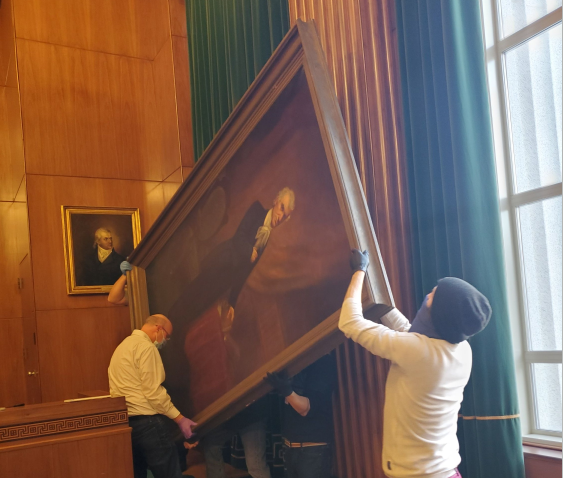Louisiana and North Carolina high courts remove Confederate iconography

Staff removed a portrait of former Chief Justice Thomas Ruffin from the North Carolina Supreme Court on Dec. 22. (Photo courtesy of the court.)
Until last month, people entering the Louisiana Supreme Court walked by a 16-foot tall monument to former Gov. Edward Douglas White, who had been a Confederate soldier, an insurrectionist who fought Louisiana's post-war Reconstruction government, and a justice on the U.S. Supreme Court. For years, activists had demanded the removal of the statue, and on Dec. 24, Christmas Eve, the court finally took it down.
A court spokesperson said the justices unanimously decided to move the statue inside the building. The statue was placed near the court's museum, which had just been renamed in honor of recently retired Chief Justice Bernette Johnson, the first Black person to lead the state judiciary. The court will add a statement to the statue to contextualize White's legacy.
Malcolm Suber of Take ‘Em Down NOLA said the group is glad the statue isn't in public view while the building is closed due to the COVID-19 pandemic, but they're also "disappointed they would have the temerity to put it inside to try to satisfy those who want to celebrate its white supremacist history." Suber said the group will continue to press for the statue's removal from the building. "We don't think he should be honored in any kind of way," he told The Times-Picayune.
Justice White, whose family owned slaves, joined the U.S. Supreme Court's 1896 decision in Plessy v. Ferguson, which upheld Louisiana's segregation laws and sanctioned racial discrimination throughout American society. The court justified segregated facilities as "separate but equal." But a dissent from Justice John Harlan, a Kentuckian, argued that segregation imposed "badges of slavery or servitude" on Black people and violated the post-Civil War constitutional amendments.
Long before White became a judge, he fought in the Confederate army. He also fought with the "Crescent City White League" in a violent 1874 insurrection called The Battle of Liberty Place, in which white supremacists killed 100 members of the state militia and ousted the state's Reconstruction government for three days.
A monument celebrating the insurrection was constructed 17 years later. The City of New Orleans removed it in 2017, along with other monuments to Confederate heroes. Then-Mayor Mitch Landreiu said, "This is about showing the whole world that we as a city and as a people are able to acknowledge, understand, reconcile — and most importantly — choose a better future."
Since then, protesters focused their attention on the White statue and other remaining Confederate symbols. On Christmas Eve, the Louisiana Supreme Court finally had the statue removed from its pedestal.
'No appeal from his master'
The day before the Louisiana statue came down, a massive portrait of former North Carolina Chief Justice Thomas Ruffin was removed from the wall where it had loomed over the high court, directly behind the chief justice's seat, for well over a century. Civil rights activists and legal scholars had long called for it to be removed.
Ruffin beat, sold, and raped people who were enslaved. And the decisions he wrote for the court sanctioned violence by other enslavers. In one infamous decision, the court overturned a $5 fine imposed on a man who beat and shot an enslaved person whom he had rented. Ruffin wrote that an enslaved person must know that "there is no appeal from his master; that his power ... is conferred by the laws of man at least, if not by the law of God."
In an interview with Facing South last year, a descendant of Ruffin and an enslaved person whom he had raped called for the court to take down the portrait. "He was a monster," she said.
The court voted to remove the portrait days after a commission recommended it. The commission had also recommended that the giant portrait be replaced by a smaller version, but the court didn't do that. Instead, the seal of the court — featuring Lady Justice, blindfolded and with balanced scales — will now hang behind the bench.
Three of the commissioners, including racial justice advocate Bree Newsome Bass, wanted the court to take down all of the portraits of former justices. Newsome Bass pointed out that the "original purpose of hanging the portraits in 1888 was to venerate three particular justices who were significant to the Confederacy."
In July, a statue of Ruffin was removed from the entrance to the building that housed the North Carolina Court of Appeals. The move followed weeks of protests against racism and police brutality, during which windows near the statue were shattered. Both of the state's appellate courts are across the street from the old state capitol building, which until last year was surrounded by monuments to heroes of the Confederate slavocracy.
The court announced on Dec. 22 that Ruffin's portrait was coming down. Then-Chief Justice Cheri Beasley, who was the first Black woman to lead the court until she lost reelection in November, said that it's "important that our courtroom spaces convey the highest ideals of justice and that people who come before our court feel comfortable knowing that they will be treated fairly."
Tags
Billy Corriher
Billy is a contributing writer with Facing South who specializes in judicial selection, voting rights, and the courts in North Carolina.
